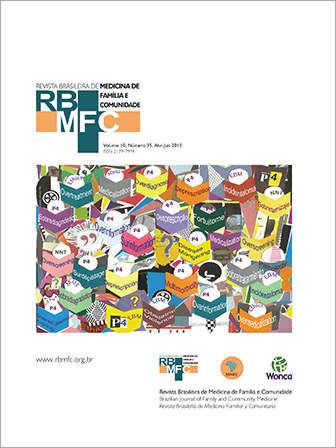Obstetric violence and quaternary prevention: what it is and what to do
DOI:
https://doi.org/10.5712/rbmfc10(35)1013Keywords:
Violence Against Women, Iatrogenic Disease, Quaternary Prevention, Personal Autonomy Delivery, ObstetricAbstract
This article aims to justify the necessity of quaternary prevention in face of ‘obstetric violence’ (OV), expression that comprises all forms of harms and violence originated by professional obstetric care, as well as to discuss actions and strategies of quaternary prevention to be taken by family physicians,primary care providers and their professional associations. The prevalence of obstetric violence in Brazil is high: ¼ of women report that they have suffered abusive treatment during birth delivery, besides the excess of unnecessary interventions (i.e. venoclisis, routine oxitocin, and episiotomy),
consequently denying them a best practice care such as vertical position, allowing the pregnant woman to freely move, eat, and have a companion during labour process. There is an excess of caesareans (55.6% of the total births) in Brazil, most prevalent on the private sector (85%) than in the public health system (40%). We propose and discuss actions of quaternary prevention against obstetric violence: (1) the elaboration (individual and collective) of birth plans oriented by primary care teams during antenatal care (for which we suggest a guideline); (2) the introduction of other qualified professionals on the caring for low risk birth (including qualified family physicians); and (3) the participation of family physicians and other primary care providers and their associations on the social and political movement for “humanization of birth”, supporting the changes on currently functioning maternity wards and new initiatives on birth delivery care.
Downloads
Metrics
References
Entrevista com Adelir Carmen Lemos de Góes [Internet]. Cientista que virou mãe; 2012 [acesso em 2015 Jun 17]. Disponível em: http://www.cientistaqueviroumae.com.br/2014/04/entrevista-com-adelir-carmen-lemos-de.html
Justiça do RS manda grávida fazer cesariana contra sua vontade [Internet]. São Paulo: Folha de São Paulo; 2014 [acesso em 2015 Jun 17]. Disponível em: http://www1.folha.uol.com.br/cotidiano/2014/04/1434570-justica-do-rs-manda-gravida-fazer-cesariana-contra-sua-vontade.shtml
Rattner D. Humanização na atenção a nascimentos e partos: ponderações sobre políticas públicas. Interface (Botucatu). 2009;13(1 supl):759-768. http://dx.doi.org/10.1590/S1414-32832009000500027. DOI: https://doi.org/10.1590/S1414-32832009000500027
Venturi G, Godinho T. Mulheres brasileiras e gênero nos espaços público e privado: uma década de mudanças na opinião pública. São Paulo: Editora Fundação Perseu Abramo/SESC-SP; 2013.
Bentzen N, editor. Wonca dictionary of general/family practice.
Copenhagen: Maanedsskrift for Praktisk Laegegerning; 2003.
Ministério da Saúde do Brasil (BR). DATASUS: Sistema de Informações de Nascidos Vivos [Internet]. Ano [acesso em 2014 July 1]. Disponível em: http://www2.datasus.gov.br/DATASUS/index.php?area=0205&VObj=http://tabnet.datasus.gov.br/cgi/deftohtm.exe?sinasc/cnv/nv
Ley Orgánica sobre el Derecho de las Mujeres a una Vida Libre de Violencia [Internet]. Gaceta Oficial 38.647. [Acesso em 2015 Jun 17]. Disponível em: http://venezuela.unfpa.org/doumentos/Ley_mujer.pdf.
Bowser D, Hill K. Exploring evidence for disrespect and abuse in facility-based childbirth: report of a landscape analysis. Bethesda, Maryland: USAID-TRAction Project; 2010.
D’Oliveira AF, Diniz SG, Schraiber LB. Violence against women in health-care institutions: an emerging problem. Lancet. 2002;359(9318):1681- 1685. http://dx.doi.org/10.1016/S0140-6736(02)08592-6. PMid:12020546. DOI: https://doi.org/10.1016/S0140-6736(02)08592-6
Goer H. Cruelty in maternity wards: fifty years later. J Perinat Educ. 2010;19(3):33-42. http://dx.doi.org/10.1624/105812410X514413. PMid:21629381. DOI: https://doi.org/10.1624/105812410X514413
Comité de América Latina y el Caribe para la Defensa de los Derechos de la Mujer (CLADEM); Centro Legal para Derechos Reproductivos y Políticas Públicas (CRLP). Silencio y cumplicidad: violencia contra la mujer em los servicios de salud em el Peru Lima. Lima: CLADEM; 1998.
National Health Service (NHS). NHS Safety Thermometer [internet]. 2013 [acesso em 2015 Jun 17]. Disponível em: http://www.safetythermometer.nhs.uk/index.php?option=com_content&view=article&id=11:maternity-homepage&catid=2:uncategorised&Itemid=285
Souza JP, Pileggi-Castro C. Sobre o parto e o nascer: a importância da prevenção quaternária. Cad Saude Publica. 2014;30(Supl):S11-S13. http://dx.doi.org/10.1590/0102-311XPE02S114. DOI: https://doi.org/10.1590/0102-311XPE02S114
Organização Mundial da Saúde (OMS). Assistência ao parto normal: um guia prático: relatório de um grupo técnico. Genebra: OMS; 1996.
Ministério da Saúde (BR). Parto, aborto e puerpério: assistência humanizada à mulher [Internet]. Brasília: Ministério da Saúde; 2001 [acesso em 2015 Jun 17]. 93 p. Disponível em: http://bvsms.saude.gov.br/bvs/publicacoes/cd04_13.pdf
Dawood F, Dowswell T, Quenby S. Intravenous fluids for reducing the duration of labour in low risk nulliparous women. Cochrane Database Syst Rev. 2013;6(6):CD007715. http://dx.doi.org/10.1002/14651858. PMid:23780639.
Costley PL, East CE. Oxytocin augmentation of labour in women with epidural analgesia for reducing operative deliveries. Cochrane Database Syst Rev. 2012;5(5):CD009241. http://dx.doi.org/10.1002/14651858. PMid:22592738. DOI: https://doi.org/10.1002/14651858
Fraser WD, Turcot L, Krauss I, Brisson-Carrol G. Amniotomy for shortening spontaneous labour. Cochrane Database Syst Rev. 2013;(6). http://dx.doi.org/10.1002/14651858.CD006167.pub4. DOI: https://doi.org/10.1002/14651858.CD006167.pub4
Lawrence A, Lewis L, Hofmeyr GJ, Dowswell T, Styles C. Maternal positions and mobility during first stage labour. Cochrane Database Syst Rev. 2009;(2):CD003934. PMid:19370591. DOI: https://doi.org/10.1002/14651858.CD003934.pub2
Priddis H, Dahlen H, Schmied V. What are the facilitators, inhibitors, and implications of birth positioning? A review of the literature. Women Birth. 2012;25(3):100-106.
http://dx.doi.org/10.1016/j.wombi.2011.05.001. PMid:21664208. DOI: https://doi.org/10.1016/j.wombi.2011.05.001
Räisänen S, Vehviläinen-Julkunen K, Gisler M, Heinonen S. A population-based register study to determine indications for episiotomy in Finland. Int J Gynaecol Obstet. 2011;115(1):26-30. http://dx.doi.org/10.1016/j.ijgo.2011.05.008. PMid:21767841. DOI: https://doi.org/10.1016/j.ijgo.2011.05.008
Carroli G, Mignini L. Episiotomy for vaginal birth. Cochrane Database Syst Rev. 2009;(1):CD000081. PMid:19160176. DOI: https://doi.org/10.1002/14651858.CD000081.pub2
Moiety FMS, Azzam AZ. Fundal pressure during the second stage of labor in a tertiary obstetric center: a prospective analysis. J Obstet Gynaecol Res. 2014;40(4):946-953. http://dx.doi.org/10.1111/jog.12284. PMid:24428496. DOI: https://doi.org/10.1111/jog.12284
Verheijen EC, Raven JH, Hofmeyr GJ. Fundal pressure during the second stage of labour. Cochrane Database Syst Rev. 2009;7(4):CD006067. PMid:19821352. DOI: https://doi.org/10.1002/14651858.CD006067.pub2
Singata M, Tranmer J, Gyte GM. Restricting oral fluid and food intake during labour. Cochrane Database Syst Rev. 2010;20(1):CD003930. PMid:20091553. DOI: https://doi.org/10.1002/14651858.CD003930.pub2
Lawrence A, Lewis L, Hofmeyr GJ, Styles C. Maternal positions and mobility during first stage labour. Cochrane Database Syst Rev. 2013;(10):1-158. http://dx.doi.org/10.1002/14651858.CD003934.pub4. DOI: https://doi.org/10.1002/14651858.CD003934.pub4
Diniz CSG, d’Orsi E, Domingues RMSM, Torres JA, Dias MAB, Schneck CA, et al. Implementação da presença de acompanhantes durante a internação para o parto: dados da pesquisa nacional Nascer no Brasil. Cad Saude Publica. 2014;30(Supl):S140-S153. http://dx.doi.org/10.1590/0102-311X00127013. DOI: https://doi.org/10.1590/0102-311X00127013
Viellas EF, Domingues RMSM, Dias MAB, Gama SGN, Theme MM Fa, Costa JV, et al. Assistência ao pré-natal no Brasil. Cad Saude Publica. 2014;30(Supl):S85-S100. DOI: https://doi.org/10.1590/0102-311X00126013
Villar J, Carroli G, Zavaleta N, Donner A, Wojdyla D, Faundes A, et al. Maternal and neonatal individual risks and benefits associated with caesarean delivery: multicentre prospective study. BMJ. 2007;335(7628):1025. http://dx.doi.org/10.1136/bmj.39363.706956.55. PMid:17977819.
Belizán JM, Althabe F, Barros FC, Alexander S, Showalter E, Griffin A, et al. Rates and implications of caesarean sections in Latin America: ecological study. BMJ. 1999;319(7222):1397-1400. http://dx.doi.org/10.1136/bmj.319.7222.1397. PMid:10574855. DOI: https://doi.org/10.1136/bmj.319.7222.1397
Ye J, Betrán AP, Guerrero Vela M, Souza JP, Zhang J. Searching for the optimal rate of medically necessary cesarean delivery. Birth. 2014;41(3):237-244. http://dx.doi.org/10.1111/birt.12104 PMid:24720614. DOI: https://doi.org/10.1111/birt.12104
Villar J, Valladares E, Wojdyla D, Zavaleta N, Carroli G, Velazco A, et al. Caesarean delivery rates and pregnancy outcomes: the 2005 WHO global survey on maternal and perinatal health in Latin America. Lancet. 2006;367(9525):1819-1829. http://dx.doi.org/10.1016/S0140-6736(06)68704-7. PMid:16753484. DOI: https://doi.org/10.1016/S0140-6736(06)68704-7
Villar J, Carroli G, Zavaleta N, Donner A, Wojdyla D, Faundes A, et al. Maternal and neonatal individual risks and benefits associated with caesarean delivery: multicentre prospective study. BMJ. 2007;335(7628):1025. http://dx.doi.org/10.1136/bmj.39363.706956.55. PMid:17977819. DOI: https://doi.org/10.1136/bmj.39363.706956.55
Morlando M, Sarno L, Napolitano R, Capone A, Tessitore G, Maruotti GM, et al. Placenta accreta: incidence and risk factors in an area with a particularly high rate of cesarean section. Acta Obstet Gynecol Scand. 2013;92(4):457-460. http://dx.doi.org/10.1111/aogs.12080. PMid:23347183. DOI: https://doi.org/10.1111/aogs.12080
Hansen AK, Wisborg K, Uldbjerg N, Henriksen TB. Risk of respiratory morbidity in term infants delivered by elective caesarean section: cohort study. BMJ. 2008;336(7635):85-87.
http://dx.doi.org/10.1136/bmj.39405.539282.BE. PMid:18077440. DOI: https://doi.org/10.1136/bmj.39405.539282.BE
Tita AT, Landon MB, Spong CY, Lai Y, Leveno KJ, Varner MW, et al. Timing of elective repeat cesarean delivery at term and neonatal outcomes. N Engl J Med. 2009;360(2):111-120. http://dx.doi.org/10.1056/NEJMoa0803267. PMid:19129525. DOI: https://doi.org/10.1056/NEJMoa0803267
Gyamfi-Bannerman C, Fuchs KM, Young OM, Hoffman MK. Nonspontaneous late preterm birth: etiology and outcomes. Am J Obstet Gynecol. 2011;205(5):456.e1-456.e6. http://dx.doi.org/10.1016/j.ajog.2011.08.007. PMid:22035950. DOI: https://doi.org/10.1016/j.ajog.2011.08.007
Bettiol H, Rona RJ, Chinn S, Goldani M, Barbieri MA. Factors associated with preterm births in southeast Brazil: a comparison of two birth cohorts born 15 years apart. Paediatr Perinat Epidemiol. 2000;14(1):30-38. http://dx.doi.org/10.1046/j.1365-3016.2000.00222.x. PMid:10703032. DOI: https://doi.org/10.1046/j.1365-3016.2000.00222.x
Leal M, Silva AAM, Dias MAB, Gama SGN, Rattner D, Moreira ME, et al. Birth in Brazil: national survey into labour and birth. Reprod Health. 2012;15(9):1-8. http://dx.doi.org/10.1186/1742-4755-9-15. PMid: 22913663. DOI: https://doi.org/10.1186/1742-4755-9-15
Hyde MJ, Modi N. The long-term effects of birth by caesarean section: the case for a randomised controlled trial. Early Hum Dev. 2012;88(12):943-949. http://dx.doi.org/10.1016/j.earlhumdev.2012.09.006. PMid:23036493. DOI: https://doi.org/10.1016/j.earlhumdev.2012.09.006
Darmasseelane K, Hyde MJ, Santhakumaran S, Gale C, Modi N. Mode of delivery and offspring body mass index, overweight and obesity in adult life: a systematic review and meta-analysis. PLoS One. 2014;9(2):e878-e896. http://dx.doi.org/10.1371/journal.pone.0087896. PMid:24586295. DOI: https://doi.org/10.1371/journal.pone.0087896
Bager P, Wohlfahrt J, Westergaard T. Caesarean delivery and risk of atopy and allergic disease: meta-analyses. Clin Exp Allergy. 2008;38(4):634-642. http://dx.doi.org/10.1111/j.1365-2222.2008.02939.x. PMid:18266879. DOI: https://doi.org/10.1111/j.1365-2222.2008.02939.x
Cho CE, Norman M. Cesarean section and development of the immune system in the offspring. Am J Obstet Gynecol. 2013;208(4):249-254. http://dx.doi.org/10.1016/j.ajog.2012.08.009. PMid:22939691. DOI: https://doi.org/10.1016/j.ajog.2012.08.009
Barros AJ, Santos IS, Matijasevich A, Domingues MR, Silveira M, Barros FC, et al. Patterns of deliveries in a Brazilian birth cohort: almost universal cesarean sections for the better-off. Rev Saude Publica. 2011;45(4):635-643. http://dx.doi.org/10.1590/S0034-89102011005000039. PMid:21670862. DOI: https://doi.org/10.1590/S0034-89102011005000039
Rattner D. Sobre a hipótese de estabilização das taxas de cesárea do Estado de São Paulo, Brasil. Rev Saude Publica. 1996;30(1):19-33. http://dx.doi.org/10.1590/S0034-89101996000100004. PMid:9008919. DOI: https://doi.org/10.1590/S0034-89101996000100004
Faúndes A, Pádua KS, Osis MJD, Cecatti JG, Sousa MH. Opinião de mulheres e médicos brasileiros sobre a preferência pela via de parto. Rev Saude Publica. 2004;38(4):488-494. http://dx.doi.org/10.1590/S0034-89102004000400002. PMid:15311287. DOI: https://doi.org/10.1590/S0034-89102004000400002
Mandarino NR, Chein MB, Monteiro F Jr, Brito LM, Lamy ZC, Nina VJ, et al. Aspectos relacionados à escolha do tipo de parto: um estudo comparativo entre uma maternidade pública e outra privada, em São Luís, Maranhão, Brasil. Cad Saude Publica. 2009;25(7):1587-1596. http://dx.doi.org/10.1590/S0102-311X2009000700017. PMid:19578580. DOI: https://doi.org/10.1590/S0102-311X2009000700017
Pang MW, Leung TN, Lau TK, Hang Chung TK. Impact of first childbirth on changes in women’s preference for mode of delivery: follow-up of a longitudinal observational study. Birth. 2008;35(2):121-128. http://dx.doi.org/10.1111/j.1523-536X.2008.00225.x. PMid:18507583. DOI: https://doi.org/10.1111/j.1523-536X.2008.00225.x
Faisal-Cury A, Menezes PR. Fatores associados à preferência por cesariana. Rev Saude Publica. 2006;4(2):21-26.
Cardoso JE, Barbosa RHS. O desencontro entre desejo e realidade: a “indústria” da cesariana entre mulheres de camadas médias no Rio de Janeiro, Brasil. Physis. 2012;22(1):35-52. http://dx.doi.org/10.1590/S0103-73312012000100003. DOI: https://doi.org/10.1590/S0103-73312012000100003
O’Dougherty M. Plot and irony in childbirth narratives of middle-class Brazilian women. Med Anthropol Q. 2013;27(1):43-62. http://dx.doi.org/10.1111/maq.12015. PMid:23674322. DOI: https://doi.org/10.1111/maq.12015
Norman AH, Tesser CD. Obstetrizes e enfermeiras obstetras no Sistema Único de Saúde e na Atenção Primária à Saúde: por uma incorporação sistêmica e progressiva. Rev Bras Med Fam Comunidade. 2015;10(34):1-7. http://dx.doi.org/10.5712/rbmfc10(34)1106. DOI: https://doi.org/10.5712/rbmfc10(34)1106
Patah LE, Malik AM. Modelos de assistência ao parto e taxa de cesária em diferentes países. Rev Saude Publica. 2011; 45(1):185-194. http://dx.doi.org/10.1590/S0034-89102011000100021. PMid:21181056. DOI: https://doi.org/10.1590/S0034-89102011000100021
Reducción de la mortalidad materna: declaración conjunta OMS/FNUAP/UNICEF/ Banco Mundial [Internet]. Ginebra: Organización Mundial de la Salud; 1999 [acesso em 2015 Jun 17]. http://whqlibdoc.who.int/publications/1999/9243561952_spa.pdf?ua=1
Mouta RJO, Progianti JM. Estratégias de luta das enfermeiras da Maternidade Leila Diniz para implantação de um modelo humanizado de assistência ao parto. Texto & Contexto – Enfermagem. 2009;18(4):731-740. http://dx.doi.org/10.1590/S0104-07072009000400015. DOI: https://doi.org/10.1590/S0104-07072009000400015
Narchi NZ. Análise do exercício de competências dos não médicos para atenção à maternidade. Saúde e Sociedade. 2010;19(1):147–158. http://dx.doi.org/10.1590/S0104-12902010000100012 DOI: https://doi.org/10.1590/S0104-12902010000100012
Sandall J, Soltani H, Gates S, Shennan A, Devane D. Midwife-led continuity models versus other models of care for childbearing women. Cochrane Database Syst Rev. 2013;8:1-107. http://dx.doi.org/10.1002/14651858.CD004667.pub3. PMid:23963739. DOI: https://doi.org/10.1002/14651858.CD004667.pub3
Faúndes A, Cecatti JG. A operação cesárea no Brasil: incidência, tendências, causas, conseqüências e propostas de ação. Cad Saude Publica. 1991;7(2):150-173. http://dx.doi.org/10.1590/S0102-311X1991000200003. PMid:15830039. DOI: https://doi.org/10.1590/S0102-311X1991000200003
Tesser CD, Knobel R, Rigon T, Bavaresco GZ. Os médicos e o excesso de cesárias no Brasil. Sau & Transf Soc. 2011:2(1):4-12. [acesso em 2015 Jun 17]. Disponível em: http://periodicos.incubadora.ufsc.br/index.php/saudeetransformacao/article/view/1088
Klein MC, Kaczorowski J, Tomkinson J, Hearps S, Baradaran N, Brant R. Family physicians who provide intrapartum care and those who do not: very different ways of viewing childbirth. Can Fam Physician. 2011;57(4):e139-e147. PMid:21490345.
Penny Simkin P. Birth plans: after 25 years, women still want to be heard. Birth. 2007;34(1):49-51. http://dx.doi.org/10.1111/j.1523-536X.2006.00126.x. PMid:17324178. DOI: https://doi.org/10.1111/j.1523-536X.2006.00126.x
World Health Organization (WHO). Birth and emergency preparedness in antenatal care. Intergrated management of pregnancy and childbirth (IMPAC). Geneva: Department of Making Pregnancy Safer, WHO; 2006 [acesso em 2015 jun 17]. Disponível em: http://www.who.int/reproductivehealth/publications/maternal_perinatal_health/emergency_preparedness_antenatal_care.pdf
Bailey JM, Crane P, Nugent CE. Childbirth education and birth plans. Obstet Gynecol Clin North Am. 2008;35(3):497-509. http://dx.doi.org/10.1016/j.ogc.2008.04.005. PMid:18760232. DOI: https://doi.org/10.1016/j.ogc.2008.04.005
Lothian J. Birth plans: the good, the bad, and the future. J Obstet Gynecol Neonatal Nurs. 2006;35(2):295-303. http://dx.doi.org/10.1111/j.1552-6909.2006.00042.x. PMid:16620258. DOI: https://doi.org/10.1111/j.1552-6909.2006.00042.x
Declercq E, Sakala C, Corry M, Applebaum S, Risher P. Listening to mothers: Report of the First National US Survey of Women’s Childbering Experiences. New York: Maternity Center Association; 2002.
Domingues RMSM, Dias MAB, Nakamura-Pereira M, Torres JA, d’Orsi E, Pereira APE, et al. Processo de decisão pelo tipo de parto no Brasil: da preferência inicial das mulheres à via de parto final. Cad Saude Publica. 2014;30(Supl):S101-S116. http://dx.doi.org/10.1590/0102-311X00105113. DOI: https://doi.org/10.1590/0102-311X00105113
Hart JT. The inverse care law. Lancet. 1971;1(7696):405-412. http://dx.doi.org/10.1016/S0140-6736(71)92410-X. PMid:4100731. DOI: https://doi.org/10.1016/S0140-6736(71)92410-X
Gérvas J, Pérez Fernández M. El fundamento científico de la función de filtro del médico general. Rev Bras Epidemiol. 2005;8(2):205-218. http://dx.doi.org/10.1590/S1415-790X2005000200013. DOI: https://doi.org/10.1590/S1415-790X2005000200013
Abenhaim HA, Welt M, Sabbah R, Audibert F. Obstetrician or family physician: are vaginal deliveries managed differently? J Obstet Gynaecol Can. 2010;29(10):801-805. DOI: https://doi.org/10.1016/S1701-2163(16)32631-7
Ministério da Saúde (BR). Portaria GM/MS no 1459, de 24 de junho de 2011. Institui no âmbito do SUS, a Rede Cegonha. Diário Oficial da União. Brasília, 2011 [acesso em 2015 jun 17]. Disponível em: http://bvsms.saude.gov.br/bvs/saudelegis/gm/2011/prt1459_24_06_2011.html
Aquino EML. Para reinventar o parto e o nascimento no Brasil: de volta ao futuro. Cad Saude Publica. 2014;30(Supl):S8-S10. http://dx.doi. org/10.1590/0102-311XPE01S114. DOI: https://doi.org/10.1590/0102-311XPE01S114
Brasil L. Maternidade Pública Sofia Feldman atrai clientes de planos de saúde [Internet]. Belo Horizonte: Revista VejaBH; 2013 [acesso em 2013 Feb 2]. Disponível em: http://vejabh.abril.com.br/edicoes/maternidade-publica-sofia-feldman-atrai-clientes-planos-saude-733707.shtml
Downloads
Published
How to Cite
Issue
Section
License
By submitting a manuscript to the RBMFC, authors retain ownership of the copyright in the article, and authorize RBMFC to publish that manuscript under the Creative Commons Attribution 4.0 license and identify itself as the vehicle of its original publication.















